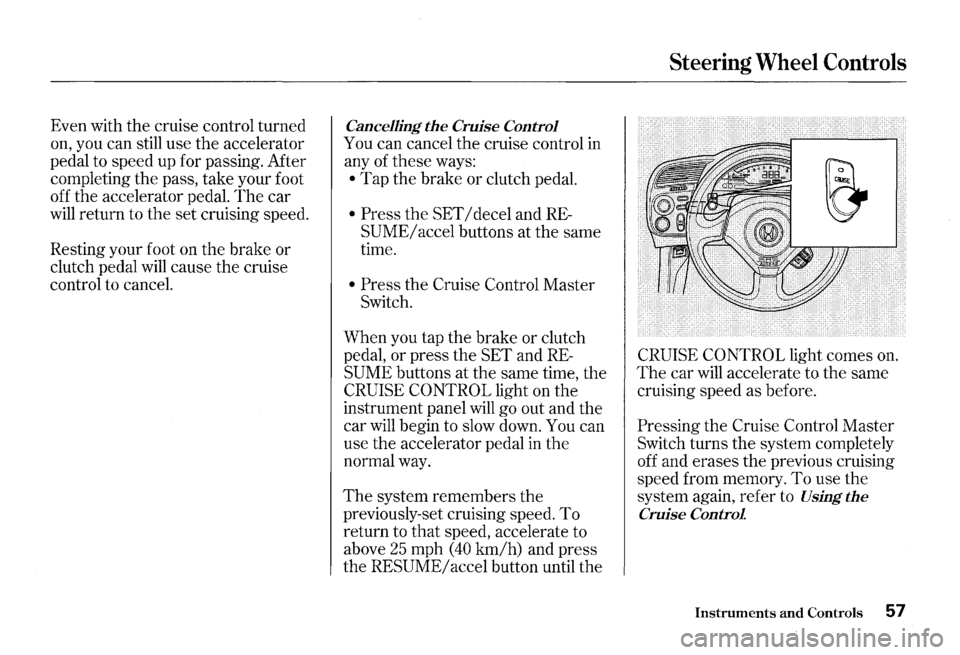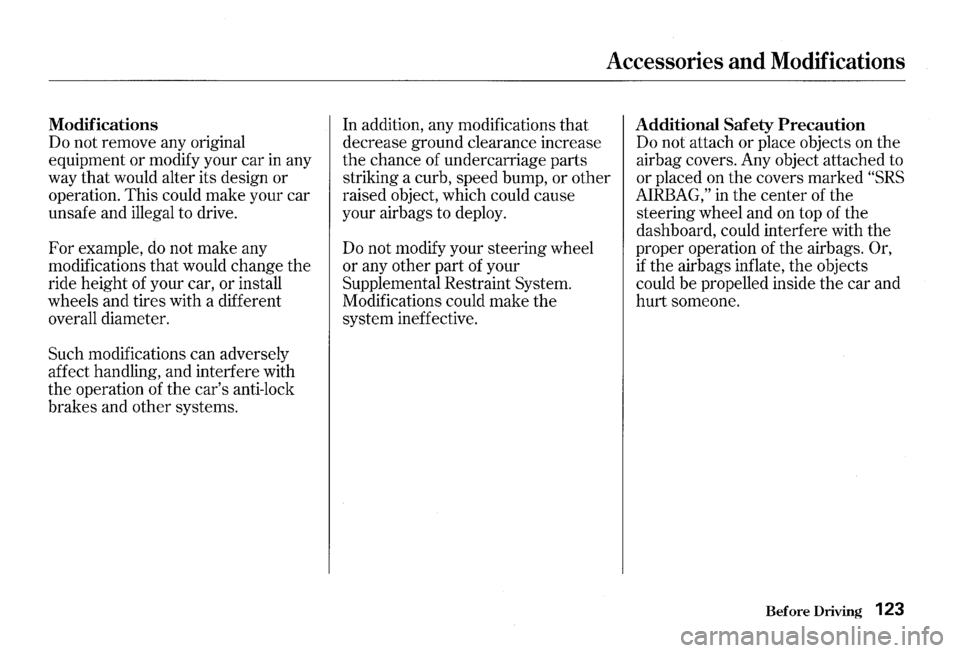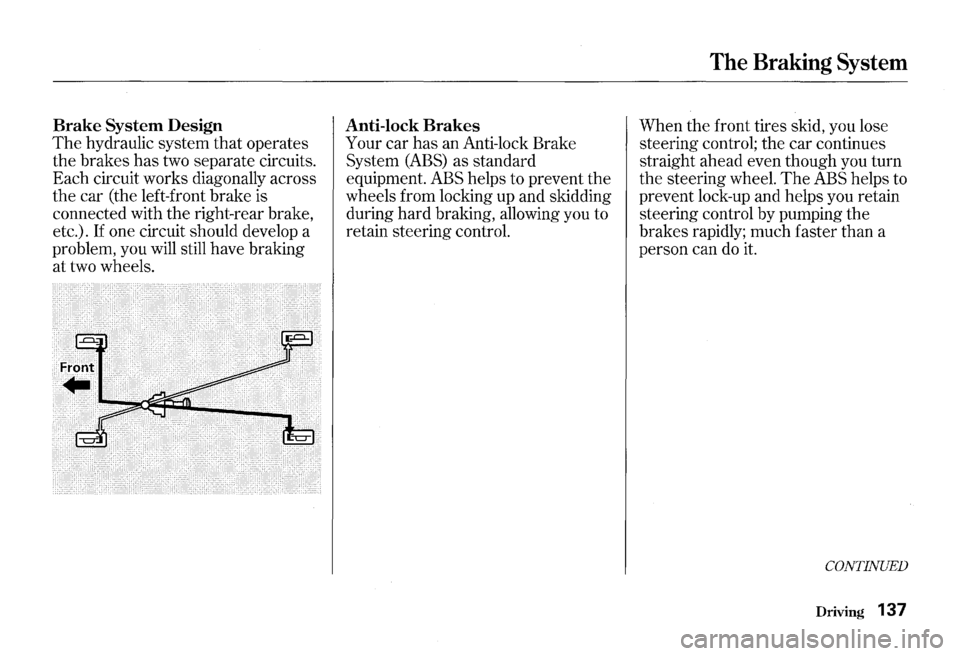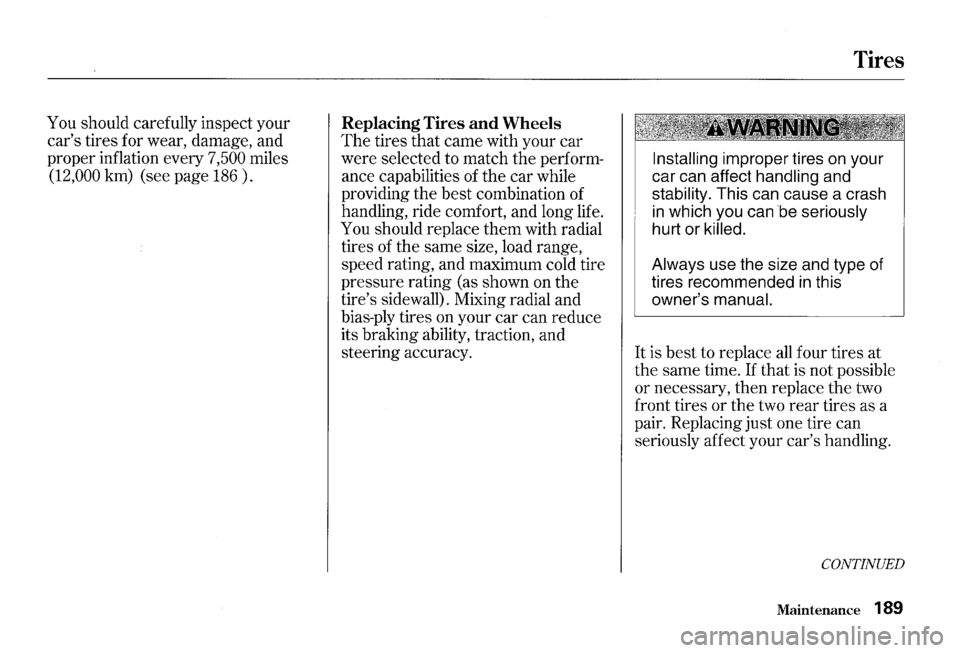2000 HONDA S2000 steering wheel
[x] Cancel search: steering wheelPage 60 of 273

Even with the cruise control turned
on, you can still use the accelerator
pedal to speed up for passing. After
completing the pass, take your foot
off the accelerator pedal.
The car
will return to the set cruising speed.
Resting your foot on the brake or
clutch pedal
will cause the cruise
control to cancel.
Cancelling the Cruise Control
You can cancel the cruise control in
any
of these ways:
• Tap the brake or clutch pedal.
• Press the SET I decel and RE
SUME/ accel buttons at the same
time.
• Press the Cruise Control Master
Switch.
When you tap the brake or clutch
pedal, or press the SET and
RE
SUME buttons at the same time, the
CRUISE CONTROL light on the
instrument panel will
go out and the
car
will begin to slow down. You can
use the accelerator pedal in the
normal way.
The system remembers the
previously-set cruising speed. To
return to that speed, accelerate to
above
25 mph (40 km/h) and press
the
RESUME/ accel button until the
Steering Wheel Controls
CRUISE CONTROL light comes on.
The car will accelerate to the same
cruising speed as before.
Pressing the Cruise Control Master
Switch turns the system completely
off and erases the previous cruising
speed from memory.
To use the
system again, refer to
Using the
Cruise Control
Instruments and Controls 57
Page 63 of 273

Keys and Locks
Ignition Switch
The ignition switch is on the right
side of the steering column.
It has
three positions:
• LOCK (0)
• ACCESSORY (I)
• ON (II)
60 Instruments and Controls
LOCK (0)-You can insert or
remove the key only in this position.
To switch from ACCESSORY to
LOCK, you must push the key in
slightly as you turn it. The anti-theft
lock will lock the steering column
when you remove the key.
If the
front wheels are turned, the anti
theft lock may sometimes make it
difficult to turn the key from
LOCK
to ACCESSORY. Firmly turn the
steering wheel to the left or to the
right as you turn the key.
Removing the key from the
ignition switch
while driving
locks the steering. This can
cause you to
lose control.
Remove the key from the
ignition switch
only when
parked.
Page 126 of 273

Modifications
Do not remove any original
equipment or modify your car in any
way
that would alter its design or
operation. This could make your car
unsafe and illegal to drive.
For example, do not make any
modifications
that would change the
ride height of your car, or install
wheels and tires with a different
overall diameter.
Such modifications can adversely
affect handling, and interfere with
the operation of the car's anti-lock
brakes and other systems.
Accessories and Modifications
In addition, any modifications that
decrease ground clearance increase
the chance of undercarriage parts
striking a curb, speed bump, or other
raised object, which could cause
your airbags to deploy.
Do not modify your steering wheel
or any other part of your
Supplemental Restraint System.
Modifications could make the
system ineffective. Additional Safety Precaution
Do not attach or place objects on the
airbag covers. Any object attached to
or placed on the covers marked
"SRS
AIRBAG," in the center of the
steering wheel and on top of the
dashboard, could interfere with the
proper operation of the airbags.
Or,
if the airbags inflate, the objects
could be propelled inside the car and
hurt someone.
Before Driving 123
Page 139 of 273

The Braking System
Your Honda is equipped with disc
brakes at
all four wheels. A power
assist helps reduce the effort needed
on the brake pedal.
The ABS helps
you retain steering control when
braking very hard.
Put your foot on the brake pedal only
when you intend to brake. Resting
your foot on the pedal keeps the
brakes applied lightly, causing them
to build up heat. Heat build-up can
reduce how well your brakes work.
It
also keeps your brake lights on all
the time, confusing drivers behind
you.
136 Driving
Constant application of the brakes
when going down a long hill builds
up heat and reduces their effective
ness.
Use the engine to assist the
brakes by downshifting to a lower
gear and taking your foot off the
accelerator pedal.
Check your brakes after driving
through deep water. Apply the
brakes moderately to see
if they feel
normal.
If not, apply them gently and
frequently until they
do. Since a
longer distance is needed to stop
with wet brakes, be extra cautious
and alert in your driving.
Brake Wear Indicators
All four brakes have audible brake
wear indicators.
When the brake pads need replacing,
you will
hear a distinctive metallic
"screeching" sound when you apply
the brakes.
If you do not have the
brake pads replaced, they will begin
screeching
all the time.
Your brakes may sometimes squeal
or squeak when you apply
them
lightly. Do not confuse this with the
brake wear indicators.
They make a
very audible
"screeching."
Page 140 of 273

Brake System Design
The hydraulic system that operates
the brakes has two separate circuits.
Each circuit works diagonally across
the car (the left-front brake is
connected with the right-rear brake,
etc.).
If one circuit should develop a
problem, you will still have braking
at two wheels.
Anti-lock Brakes
Your car has an Anti-lock Brake
System
(ABS) as standard
equipment. ABS helps to prevent the
wheels from locking up and skidding
during hard braking, allowing you to
retain steering control.
The Braking System
When the front tires skid, you lose
steering control; the car continues
straight ahead even though you turn
the steering wheel.
The ABS helps to
prevent lock-up and helps you retain
steering control by pumping the
brakes rapidly; much faster than a
person can do
it.
CONTINUED
Driving 137
Page 141 of 273

The Braking System
You should never pump the
brake pedal, this defeats the
purpose of the ABS. Let the ABS
work for you by always keeping firm,
steady pressure on the brake pedal
as you
steer away from the hazard.
This is sometimes referred to as
"stomp and steer."
You will feel a pulsation in the brake
pedal when the
ABS activates, and
you may
hear some noise. This is
normal, it is the
ABS rapidly
pumping the brakes.
Activation varies with the amount of
traction your tires have.
On dry
pavement, you will need to press on
the brake pedal very
hard before you
activate the
ABS. However, you may
feel the
ABS activate immediately if
you are trying to stop on snow or ice.
138
Driving
Important Safety Reminders
ABS does not reduce the time or
distance it takes to stop the car, it
only helps with steering control
during braking. You should always
maintain a safe following distance
from other vehicles.
ABS will not prevent a skid that
results from changing direction
abruptly, such as trying to take a
corner too fast or making a sudden
lane change. Always drive at a safe,
prudent speed for the road and
weather conditions.
ABS cannot prevent a loss of
stability. Always steer moderately
when you are braking hard.
Severe
or sharp steering wheel movement
can still cause your car to veer into
oncoming traffic
or off the road.
A car with ABS may require a
longer
distance to stop on loose or
uneven surfaces, such as gravel
or
snow, than a car without anti-lock.
Slow down and allow a greater
distance between cars under those
conditions.
Page 143 of 273

Driving in Bad Weather
Rain, fog, and snow conditions re
quire a different driving technique
because of reduced traction and
visibility. Keep your car well
maintained and exercise greater
caution when you need to drive in
bad weather.
The cruise control
should not be used in these condi
tions.
140 Driving
Driving Technique -Always drive
slower than you would
in dry
weather.
It takes your car longer to
react, even
in conditions that may
seem just barely damp. Apply
smooth, even pressure to
all the
controls. Abrupt steering wheel
movements or sudden, hard appli
cation of the brakes can cause loss of
control in wet weather. Be extra
cautious for the first few miles
(kilometers) of driving while you
adjust to the change in driving
conditions.
This is especially true in
snow. A person can forget some
snow-driving techniques during the
summer months.
Practice is needed
to relearn those skills.
Exercise extra caution when driving
in rain after a long dry spell. After
months of dry weather, the first
rains bring
oil to the surface of the
roadway, making it slippery.
Visibility -Being able to see
clearly in
all directions and being
visible to other drivers are important
in all weather conditions. This is
more difficult
in bad weather. To be
seen more clearly during daylight
hours, turn on your headlights.
Inspect your windshield wipers and
washers frequently. Keep the wind
shield washer reservoir full of the
proper fluid. Have the windshield
wiper blades replaced
if they start to
streak the windshield or leave parts
unwiped.
Use the defrosters and air
conditioning to keep the windows
from fogging up on
the inside (see
page
91 ).
Page 192 of 273

You should carefully inspect your
car's tires for wear, damage, and
proper inflation every
7,500 miles
(12,000 km) (see page 186 ) .
Replacing Tires and Wheels
The tires that came with your car
were selected to match the perform
ance capabilities of the car while
providing the best combination of
handling, ride comfort, and long life.
You should replace them with radial
tires of the same size, load range,
speed rating, and maximum cold tire
pressure rating (as shown on the
tire's sidewall). Mixing radial and
bias-ply tires on your car can reduce
its braking ability, traction, and
steering accuracy.
Tires
Installing improper tires on your
car can affect
handling and
stability. This can cause a crash
in which you can be seriously
hurt or killed.
Always
use the size and type of
tires recommended
in this
owner's
manual.
It is best to replace all four tires at
the same time. If that is not possible
or necessary, then replace the two
front tires or the two
rear tires as a
pair. Replacing just one tire can
seriously affect your car's handling.
CONTINUED
Maintenance 189